Zoot Suit Riots: Opportunities for Discovery using Suggested Searches in Hispanic Life in America
In many of its primary source collections, Readex provides a significant enhancement for the user by including Suggested Searches to jumpstart research. Created and curated by the Readex editorial and content experts, Suggested Searches are tailored searches to the collection, divided into eras and then further refined by relevant topics. Both novice and advanced researchers can easily begin their research by using the Suggested Searches enhancement available in many Readex collections.
Hispanic Life in America
One era in the Suggested Searches, “Zoot Suit Riots to West Side Story (1943-1961)", caught this writer's attention. I knew what the suits were and what they looked like but had no idea how they led to riots.
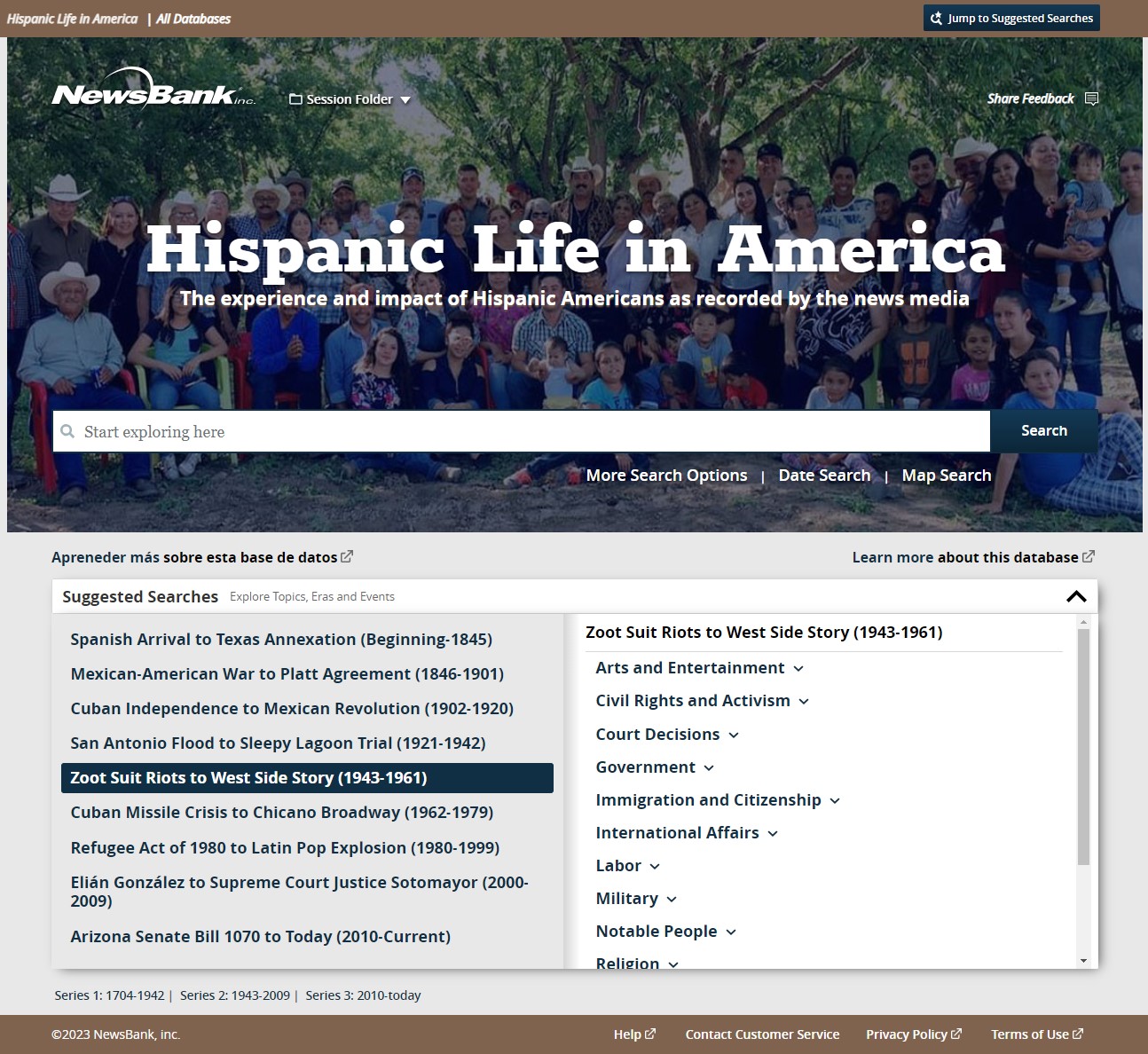
The Early Years of Zoot Suits
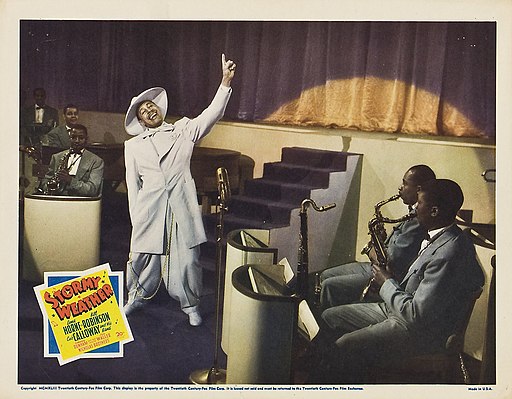
Zoot suit! It’s fun to say! It was fun to wear, fun to see, and fun to dance in. It was all fun until people began hurting each other. We begin with the fun.
The zoot suit emerged in the 1930s as it became popular with musicians, especially among people of color. The suit jackets were fashioned with wide shoulders, tight waists, and were longer than conventional apparel. The trousers were high-waisted and were unusually wide at the knees and narrow at the cuffs. Colors were dark blues, blacks, and greys although Black musicians favored added colors and pinstripes.
Early in 1942, a record was released titled “A Zoot Suit for My Sunday Gal.” It swept the nation. The lyrics:
I want a zoot suit with a reat pleat, with a drape shape, and a stuff cuff, to look sharp enough to see my Sunday gal.
I want a reave sleeve with a ripe stripe and a dressed vest with a glad plaid in the latest fad to see my Sunday gal.
This “latest fad” was nationwide in urban areas including Los Angeles which had population of about three million Mexican Americans, many of whom were descendants of people who had lived there for generations. Others were immigrants who had been lured by the promise of jobs.
The history which led to the riots is complex and rife with racism, imperialism, extra-legal deportation, and suffering. This all can be explored by using the first four eras in Hispanic Life in America that preceded the riots. The era of “San Antonio Flood to Sleepy Lagoon Trial (1921-1942)" includes the topic “Immigration and Citizenship” where the researcher can learn about the “Undesirable Aliens Act of 1929” and the “Forced repatriation of Mexican Americans during Great Depression.”
Herbert Hoover targeted Mexican Americans as the cause of the Great Depression and instituted the mass deportation. There may have been as many as two million people repatriated of whom more than half, including many children, were U.S. citizens. Ostensibly, the deportations would protect jobs for “real” Americans. Appreciation of the events of the 1930s is useful in understanding what gave rise to the riots in 1943.
The Lead Up to the Zoot Suit Riots
The zoot suit fun began to fade in the early years of World War II. The federal War Production Board was established in January 1942. Among its powers was the allocation of materials and banning the manufacture of nonessential products. Zoot suits, which required much more material than other styles, were prohibited. While they could no longer be purchased, aficionados continued to wear them.
In Los Angeles, defense industries ramped up while tens of thousands of service personnel swarmed to the region to await being shipped out to the Pacific theater. Tension soon developed between the recruits and the zoot suiters many of whom were employed in the defense factories. A widely circulated sports columnist, Henry McLemore, best remembered for his advocacy of the internment of Japanese Americans, published a column which sympathetically describes the lives of these young Angelenos.
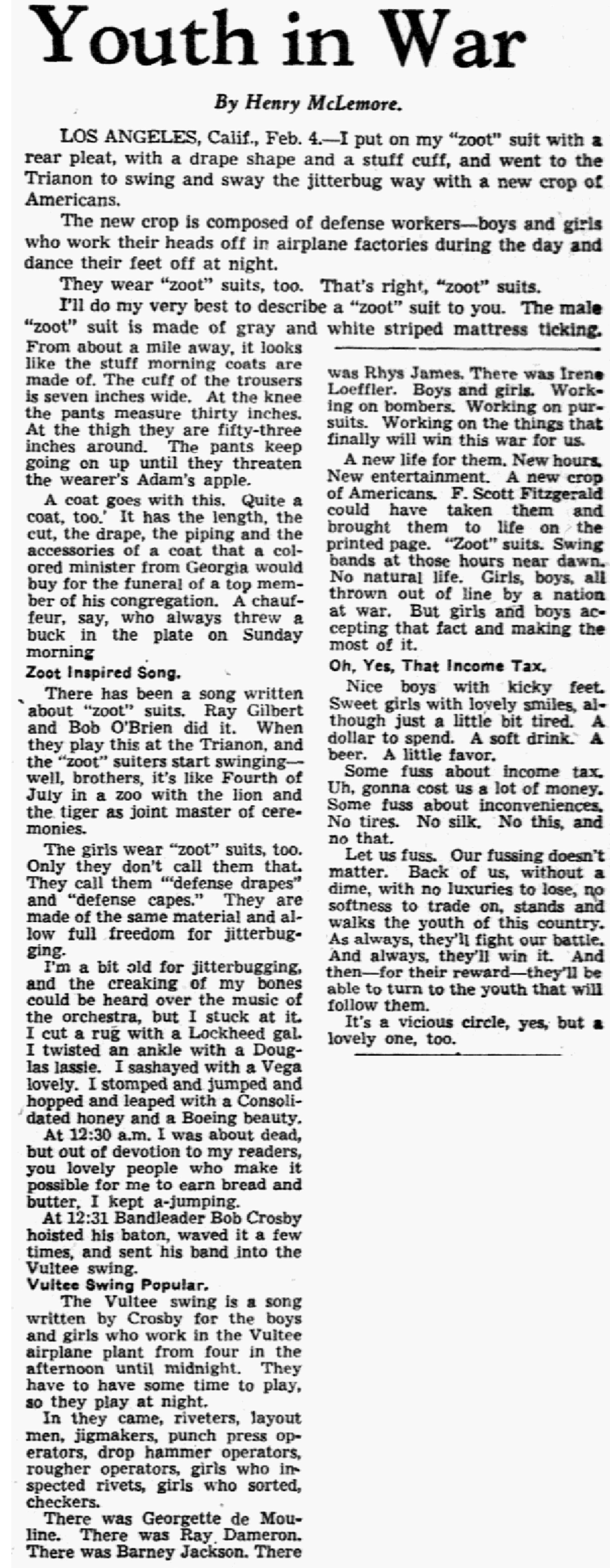
In retrospect, it is not difficult to see the casual racism in newspapers accounts of any crime that involved a person of color. Some examples:
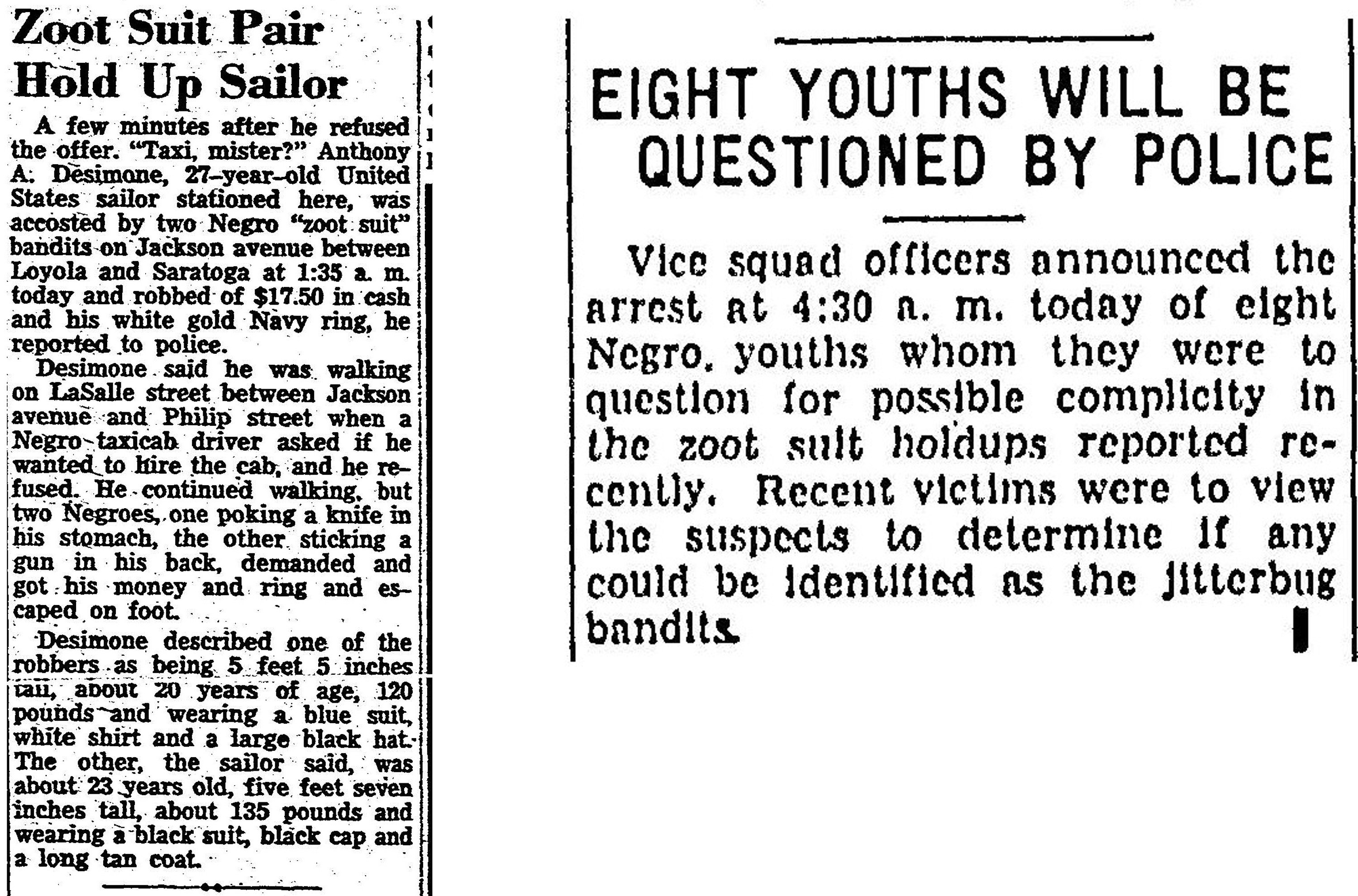
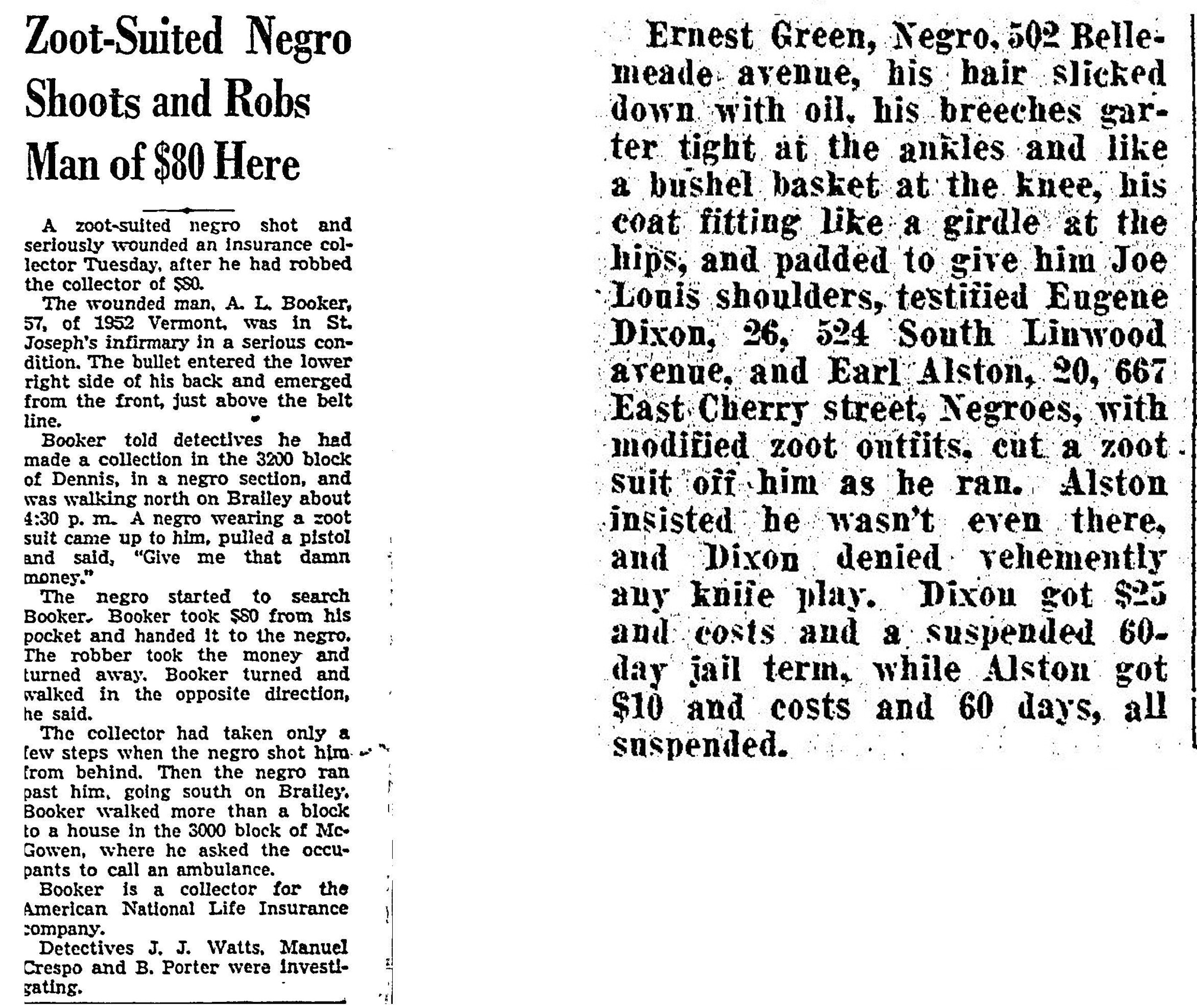
The practice in the press in those days appears to have been identifying people of color, as Negroes or Mexicans, particularly those engaged in criminal activity. Identifying a perpetrator as white was not done, while identifying a victim as white was common.
Possibly, the zoot suitors antagonized some of the servicemen because of their color, but the ostensible reason for their hostility was their perception that the anyone wearing the suit was unpatriotic and flouting the War Production Board. An AP article which appeared in the Kingston, New York Daily Freeman on April 5, 1943, reported that the marines in the South Pacific had two pet peeves: strikes and zoot suits. "... a magazine or newspaper shot of a zoot-suited lad would set off a marine’s temper every time."
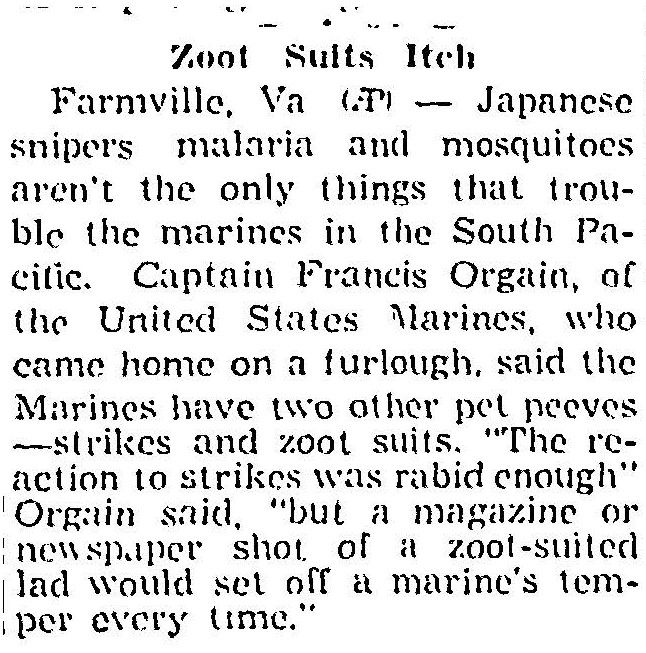
This same sentiment was the subject of a syndicated political cartoon which appeared in the February 16, 1943, issue of The Tacoma News Tribune.
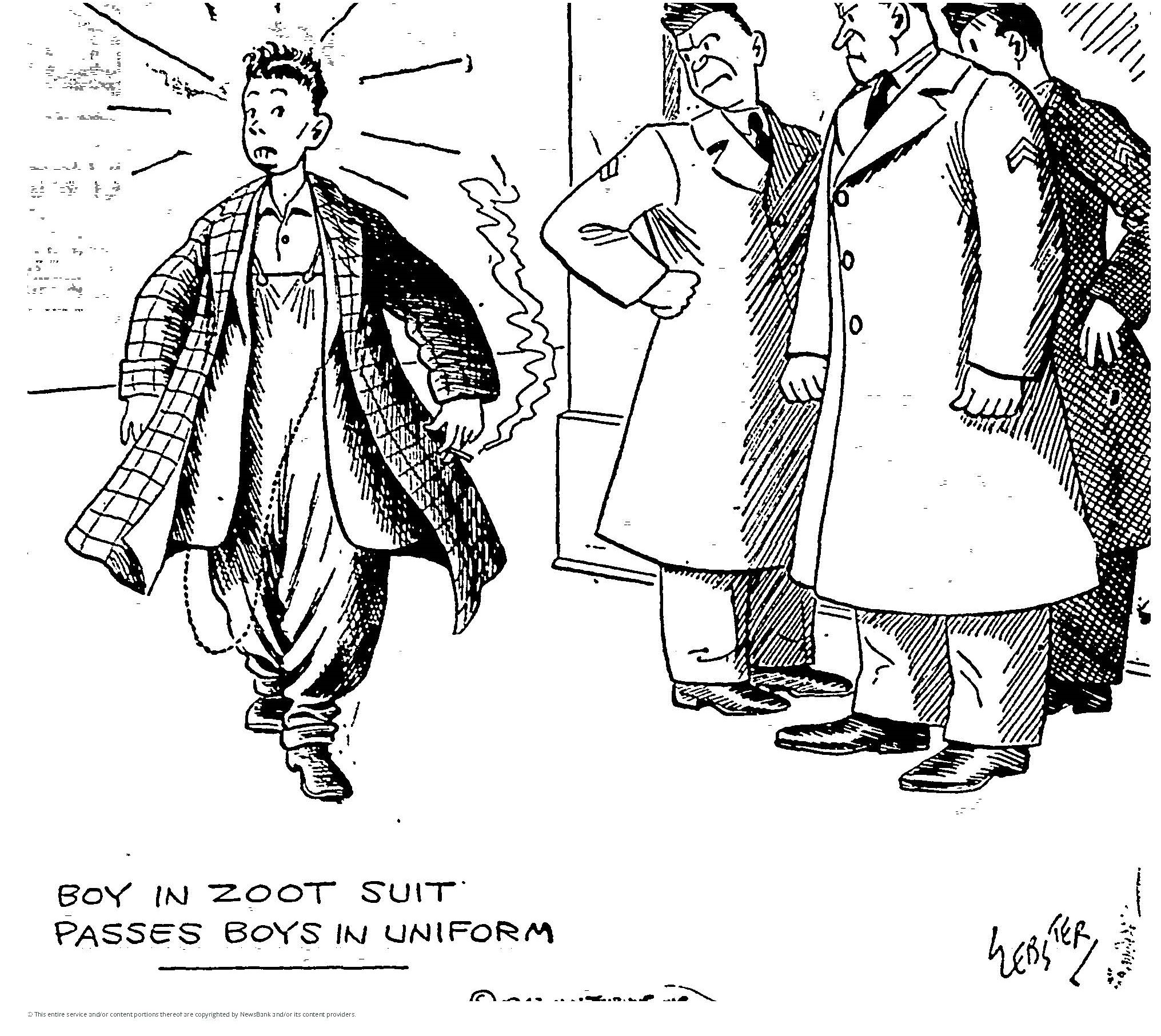
There were strikingly different opinions on the sociological interpretations of the symbolism of zoot suit and the intents of those who wore them. On March 15, 1943, the New York Post published an AP article titled “Are Zoot-Suits Zooting From Dancing To Gangsterism?” It described the formation of a committee by the Detroit Association for the Study of Group Work “to find out what makes the zoot-suiter zoot.”
A professor at the School of Public Affairs and Social Work of Wayne State University is quoted:
'We feel,' he says, 'that the phenomenon is frightening enough in some of its implications to have the group workers worried, and interesting enough in its manifestations to promise insights into the nature of present-day phenomena.' He further asserted that 'In some places and at certain times. The original basis of dance enjoyment seems to be brushed aside by an interest in tough-guy behavior, in alcohol excesses, in rebelliously manifested freedom of inhibition in social relations with the other sex.'

In contrast, an April 5,1943, reprint of an article from the Los Angeles Times in The Kansas City Star provided a less fraught assessment of zoot suiters titled “Last Days of a ‘Stylish Zoot.’” It avers that:
In Los Angeles zoot suits are still widely worn among a certain clientele on the other side of the tracks, worn with gusto by young men who are not afraid to be different. But they violate OPA rules at so many places that long since none has been manufactured, and when the current ones are worn out there will be no more zoot suits.
The author describes a recent court case.
Latterly a Southern California judge condemned two young Mexicans who had been boisterous near a cop to wear their zoot suits no longer, and they wept, actually wept, so much does youth want to be outlandish.
His honor was barking up the wrong tree, however, for the zoot suit is no label of juvenile delinquency. Many a young Mexican in a zoot suit works hard and takes his money home to mamacita for frijoles refrites, and many a young zoot-suited Negro never shoots craps but goes to the Baptist church every Sunday.
It is striking that the author employs racial stereotypes while being clearly sympathetic. Consider the following:
Zoot suits were made by manufacturers all over the country, and sold like hot cakes. The more conservative young men didn’t go for them, not even the college boys who, the Lord knows, are not very conservative. They went for them in the foreign districts: in fact the name seems to derive from a mispronunciation of the word ‘suit.’
‘I wanna buya zoot,’ the customer would say in East St. Louis. ‘I wunt [sic] pay no mor’n [sic] $20, wid altercations.’
'Very well, sir,’ the clerk would answer. ‘Here you have a very stylish zoot.’
Note the malaprop ‘altercations.’ It was an established conceit among many white people that black dialect was imbued with error. Despite the inherent racism of the author, he concludes with a generous understanding.
If clothes are worn for satisfaction of the inner man the zoot suit has fulfilled its purpose. It has given joy to the wearers and probably to their girl friends who have come to associate the zoot suit with manly virtue and an elegance of sorts. For style, like love, is an illusion.

On April 24, 1943, the New York Post published an unusual article by Mary Heaton Vorse who was a prominent journalist and labor activist. The dateline is Los Angeles, and the subject was the pervasive “history of abuse and discrimination against Mexican youth” and “the flagrant miscarriage of justice in the sentencing of 17 young Mexican boys for an alleged murder.” In the article, Vorse laments that this miscarriage of justice provided fodder for our enemies.
Quick to seize on such rich material, Axis propagandists used the case to good effect. ‘Here’s your good neighbor policy.’ Axis agents shouted through Mexico Central and South America. These severe sentences, without adequate evidence, became an international incident.
The whole article merits reading.
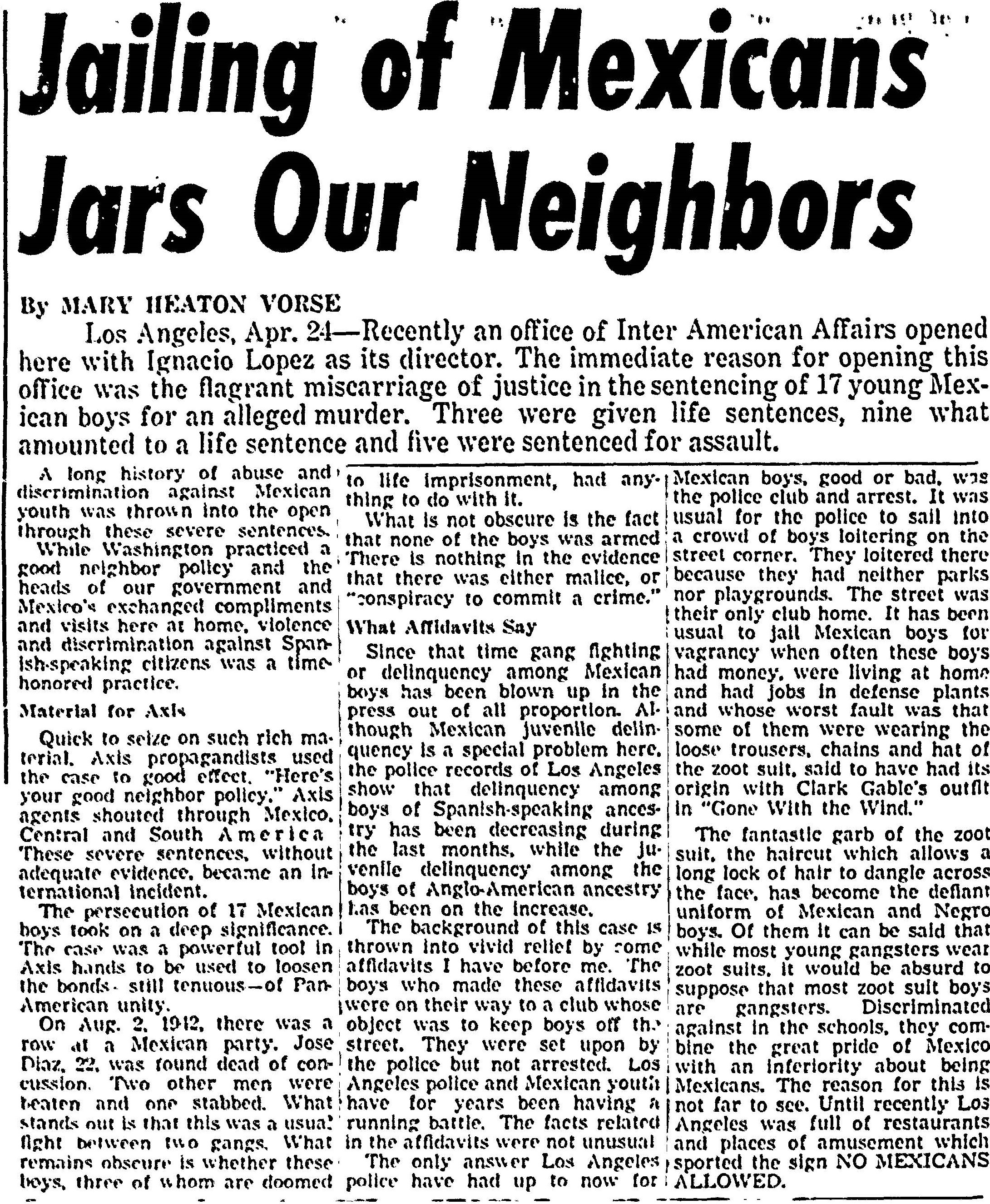
Zoot Suit Riots
By May 1943, the tensions between the servicemen and the zoot suiters were ratcheting up. On the 10th of the month, the Los Angeles Examiner reported on a melee at the Venice Pier.
Thirteen ‘zoot suiters’ were in Venice jail yesterday following a riot which resulted in a pitched battle with soldiers, sailors and Marines, and required police from Los Angeles, Santa Monica and near-by beach cities to break it up.” Even though police “found several hundred uniformed men milling about with high school boys and vowing to ‘get’ every zoot suiter they could find.”, no servicemen were arrested.

In early June, servicemen from the Navy and Marines organized a vigilante attack on zoot suiters ostensibly avenging earlier attacks by zoot suiters on some of them and their wives. A wire service account was published by the Atlanta Journal on June 5th.
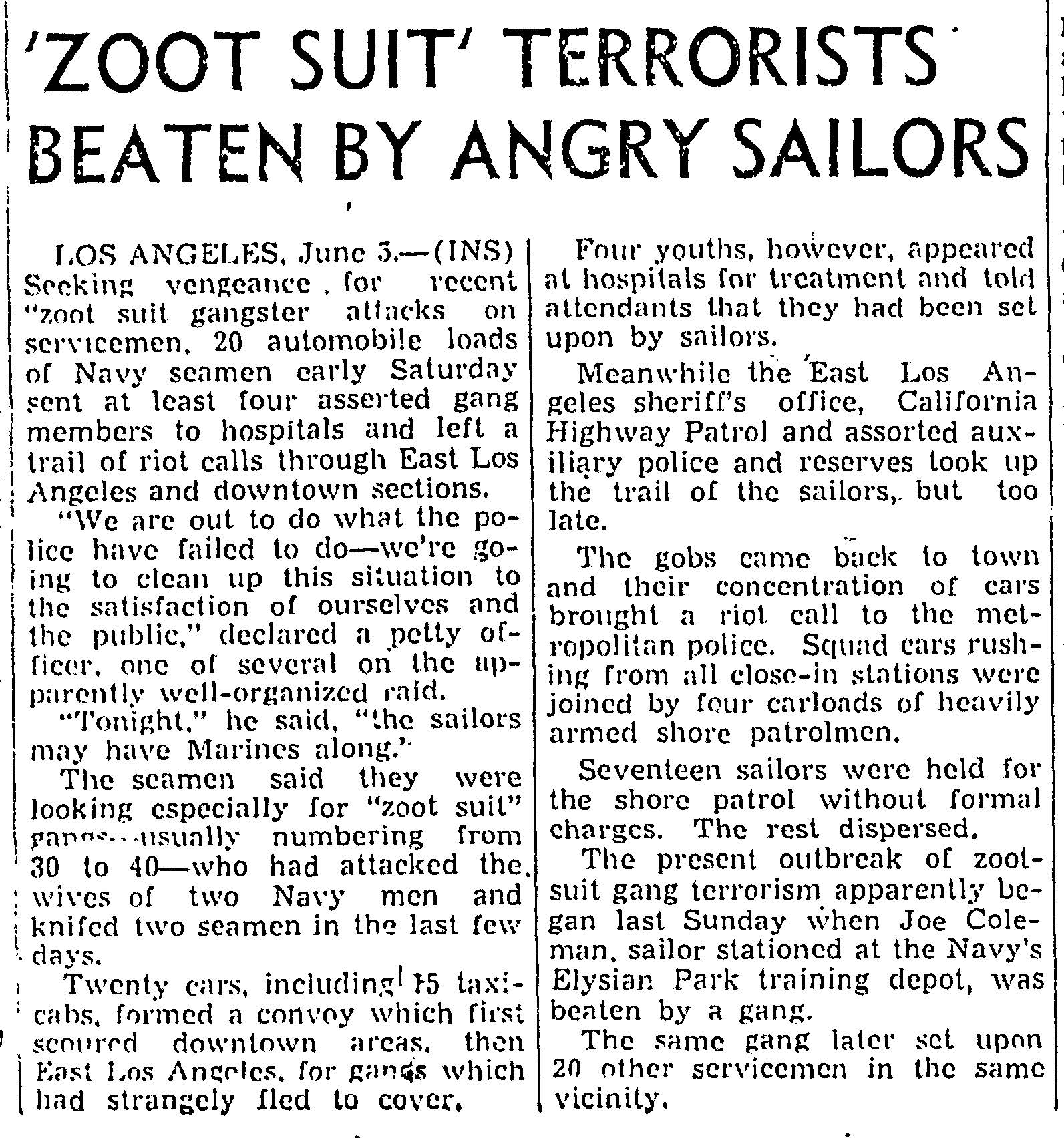
An AP article describing the arrest of “15 zoot suit clad youths” in L.A. appeared in the Bellingham [Washington] Herald on the 6th with the headline “Zoot Suit Gangs Roam Los Angeles.”
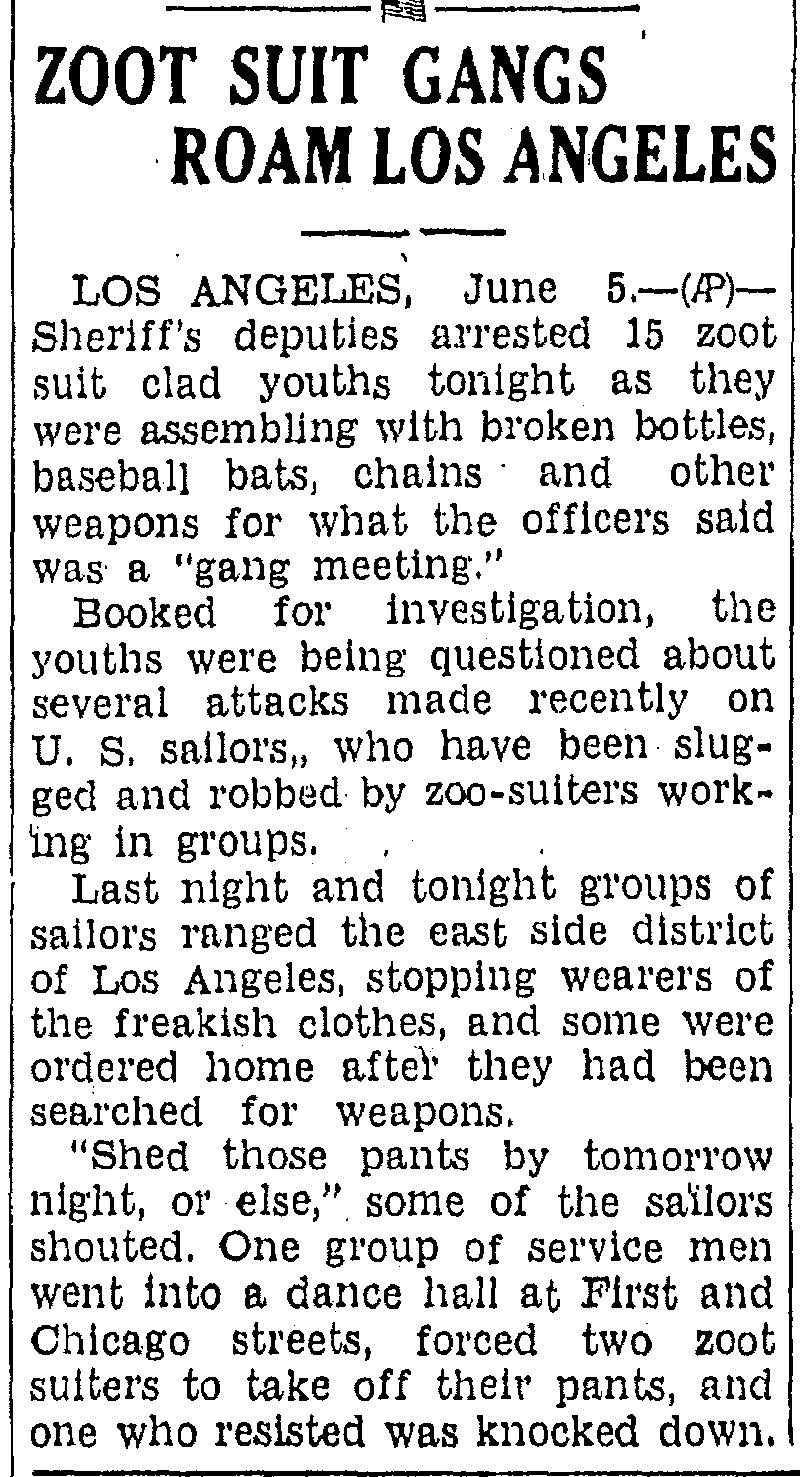
The next day, a UP article, which appeared in the Charleston Evening Post and many other newspapers, declared victory as announced by its headline, “All Quiet Now on ‘Zoot Suit’ Front in Los Angeles.”

On the 8th of June, the Los Angeles Examiner published a lengthy front-page article under a blazing headline: “Thousands of Enraged Service Men Hunt Down Zoot Suiters.” It provides a comprehensive account of the riots.
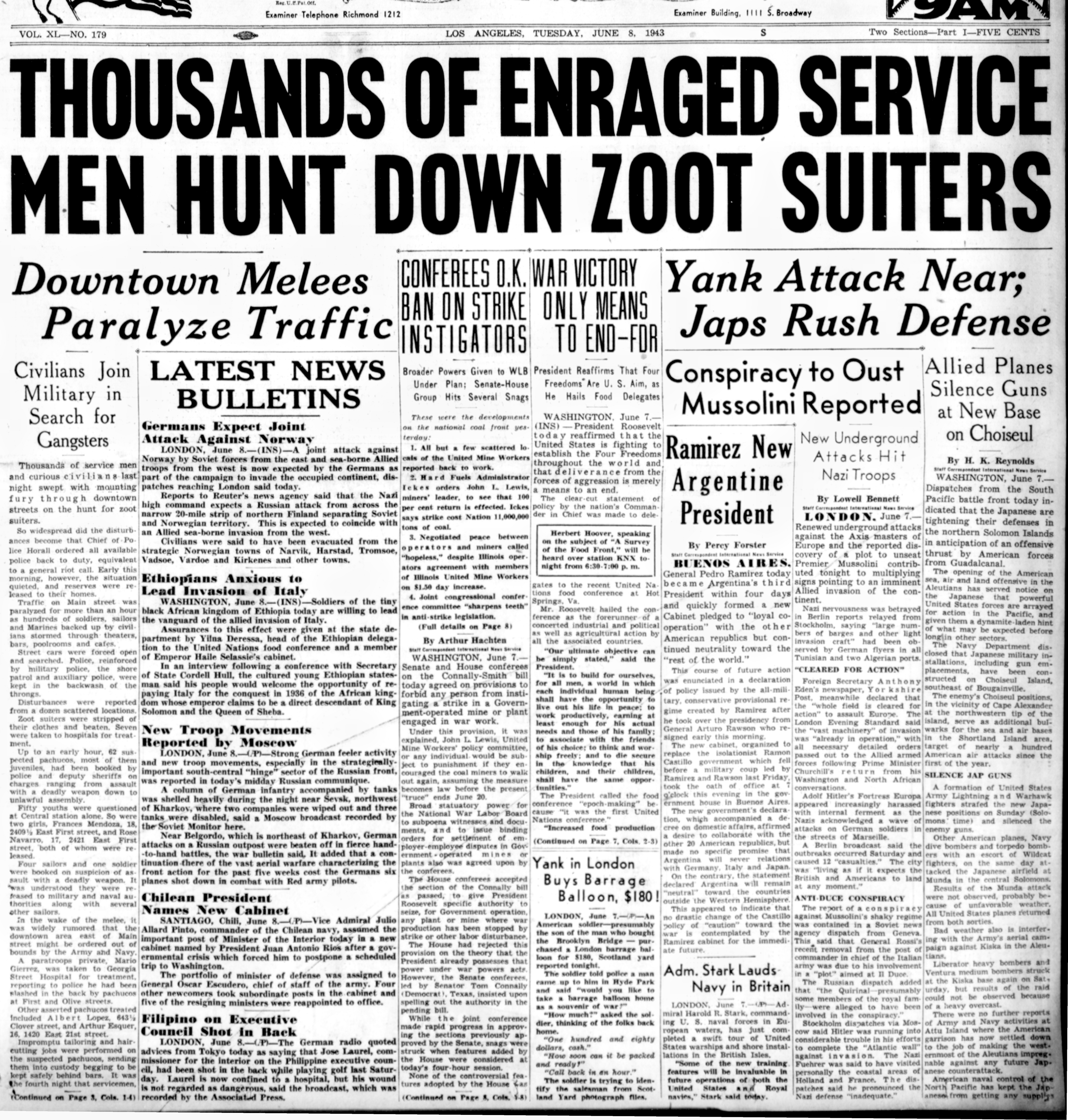
It is continued on page 3.
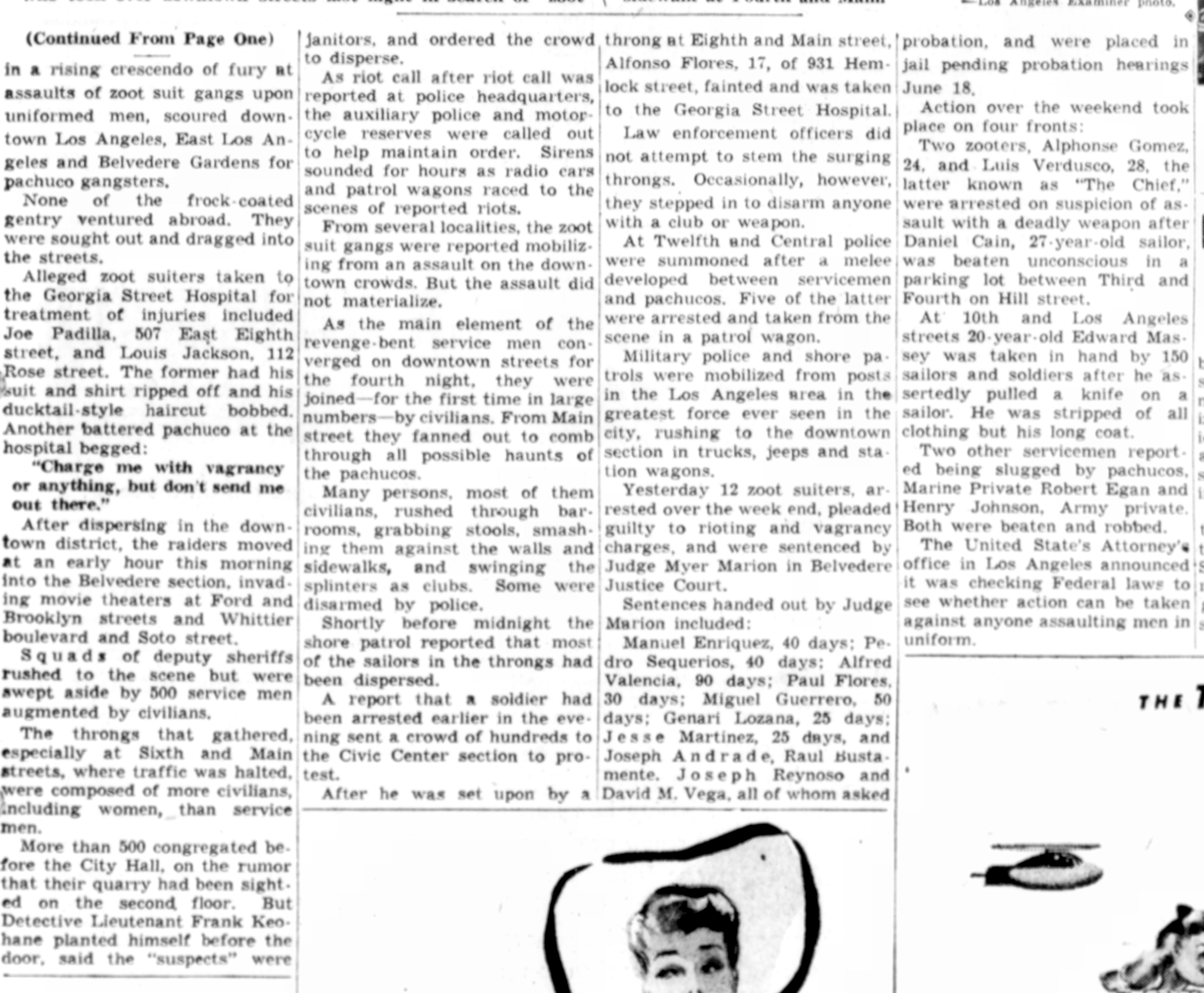
This blog does not pretend to be an exhaustive investigation of the Zoot Suit Riots. Rather, it is intended to relate a particular experience, to wit; the joy of discovery for one enthusiastic and curious user of the Suggested Searches function of this, and many other primary source collections from Readex. They provided this user with portals through which it was possible to explore and better understand one event in the history of Hispanic life in America.
Visit the Readex Hispanic Life in America page for information on this collection and to request a complimentary trial.



